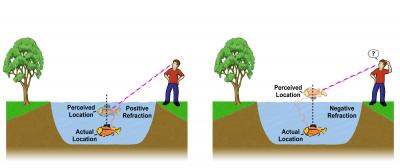A material's refractive index is a measure of how much the speed of light changes when it enters that material. Light traveling through a vacuum has a refractive index of 1, while glass has an index of approximately 1.5 and water has an index of approximately 1.3. When traveling between mediums, the difference between the refractive indices of the two substances determines how much the light will bend as it passes through the boundary between the two. A classic example is a straw in a glass of water not appearing straight due to the difference in refractive indices between the air, water, and glass. This phenomenon also causes deep water to look shallow - the light coming from the bottom of pond is bent to a shallower angle as it enters the air, tricking our brain into thinking the point we're viewing is much closer to the surface of the water than it is.

Fish out of water: If water had a negative index of refraction, it would create the illusion that a fish was swimming in the air above the water instead of in the water. Photo Credit: Jason Valentine and Robert Lee
For a long time, whether materials with a negative refractive index could even be created was questioned. Metamaterials have never been observed in nature, and their unique properties seemed the stuff of science fiction until just a few years ago. In 2005, a group at the U.S. Department of Energy's Ames Laboratory led by Costas Soukoulis won the 1 million euro Descartes Prize by demonstrating the reality of metamaterials. In the time since, research into metamaterials has exploded. The Ames Laboratory team demonstrated metamaterials that worked at the long wavelengths of the radio end of the spectrum only - but now, they and other teams have created a metamaterial that has a refractive index of -0.6 at a wavelength of 780 nanometers - part of the visible light spectrum.
To create a metamaterial, matter must be manipulated at dimensions smaller than the wavelength of the incident light. Because of this, researchers have had much more success creating metamaterials that work at the lower wavelengths of radio waves and microwaves. The visible spectrum, however, begins at a wavelength of about 800 nanometers for red light to 400 for violet light - a much more difficult scale for manufacturing.
Now that they exist, metamaterials make huge promises for practical applications. For instance, metamaterials will be able to create optical microscopes with resolution far greater than is currently available and may also drastically reduce the size of radio antennas - paving the way for smaller wireless devices and towers. Most importantly for science fiction fans, though, is the possibility of the cloaking device.
In April 2008, Tomoshiro Ochiai, a lecturer at Toyama Prefectural University and two other
researchers from University of St Andrews in Scotland, UK and Future
University-Hakodate, created a theoretical model of an invisibility cloak using five different materials - some with a negative index of refraction. The model is promising but has some difficulties - for instance, the area available for placing the object one wishes to hide is only 1/10 the diameter of the entire cloak. Also, the cloak is cylindrical, so it would only camoflage something when viewed from the curved side. Still, it's a significant breakththrough.
We may not see any commercially available invisibility cloaks any time soon, but we may see the benefits of metamaterials emerge in the very near future, from smaller cell phones to superlenses.
References:
Nozawa, Tetsuo. "'Invisibility Cloak' Realized in Theory." TechOn Magazine, April 18, 2008






Comments